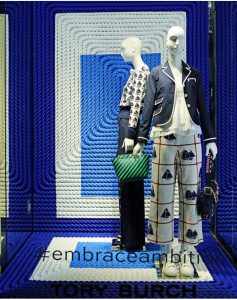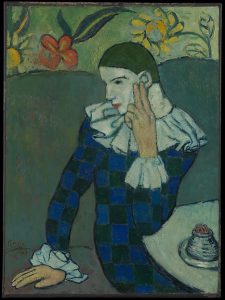Abstract
Elements of design are the very characteristics we use to describe the structure of a piece and critique it. Characteristics that make up elements of design are hues, texture, line and shape (Adomaitis,2017). Elements of design are often used to analyses pieces of art, however the fashion industry is able to utilize those very same elements in critiquing a fashion composition. Although not often categorized as a form of art fashion is an element in our culture that thrives off artistic expression, and technique just like a piece of fine art. This paper will critique a classic by Pablo Picasso and a Tory Burch Madison Avenue window. By critiquing both forms of art, the comprehension of fashion jargon will be established as well as a greater appreciation for techniques utilized for both and fashion.
Keywords: Pablo Picasso, Tory Burch, Elements of Design
Art and fashion play a significant role when analyzing the social and political aspect of their time. Being able to critique fashion and/or art enables one to comprehend the social and political feels of that time. The Seated Harlequin a painting by Pablo Picasso (figure 2), and the Tory Burch Window for spring 2017 in Madison Ave (figure 1) will be critiqued to further understand elements of design such as hue’s, texture, and line. The Seated Harlequin and Tory Burch were specifically chosen to aid in the comprehension of this paper due to their significant and influential roles in their separate industries. Picasso born in Spain 1881 goes down in history has one of the most influential artist of the 20th century because of his creation of cubism and contributions to symbolism and surrealism (“Pablo Picasso”, 2015). Tory Burch founded in 2002 started off as a small boutique in Nolita, New York that has expanded into an American fashion power house(“About the Company”, 2017). Bot+h power houses curated unique styles that exhibited the distinguishing significance of their time.
The Seated Harlequin (figure2) was established after Picasso played with a variation of styles to establish a line of 6 canvasses in 1901 that each uniquely had people seated at a café but together became a single composition (Mr. and Mrs. John L. Loeb, 1960). The first elements of design that will be utilized to describe this painting are hues. Hues can be defined as the shades and tints used to emphasize a feeling in a composition (Bell& Ternus,2010). The painting includes all primary hues combined with secondary hues such as green and turquoise. In this portrait tones are established within each of the hues utilized. Tones are created when adding both black and white to a hue (2010). This makes the painting appear less intense by establishing a dullness to hues. The dominant hues in this painting is blue; the recurrence of blue appears in different tint, and even as an undertone in the white face and cuffs. The hues in this composition are adjacent (blue and green) which aid in easy transitions as a result, lacks any sharp differences in hue which aid in the dullness of this composition. Overall the soberness of the hues presented aid in establishing a pensive mood within the painting.
The soberness of the hues presented in figure 2 displays a different tone then of the visual display window (figure1) composed by Tory Burch for spring 2017. The Hues for one are intense which bring about brightness to the composition. This window utilizes a dark blue hue on the garments and are reiterated on the back drop to create a monochromatic feel that goes from dark blue to white to baby blue. The monochromatic feel of the composition aids in easy transitions therefor creating a lack of contrast within the hues, similar the lack of contrast present in the Seated Harlequin. The blue presented in the garments represent intelligence and sophistication that can be correlated with the image of the brand. The white presented implements elegance to this composition. The repetition of these dominant hues blue and white set the overall tone for the composition which aids in targeting a market who exude or conduct themselves in a matter to the characters resented in this composition.
The second element of design that will be discussed are the line. The lines can be defined as the direction of a composition that aid in revealing the tone of the piece (Bell & Ternus, 2010). In the Seated Harlequin , straight lines are not presented in the composition. The lines painted are curved, from the ruffles on the harlequin’s blouse, the shape of his body, and the background (the flowers, and couch). Curved lines have a softening effect to a painting that can be viewed as graceful and express the fluidity of an image. It is understood that the painting itself is a representation of Picasso’s grieving experience with the suicide of his friend Carles Casagemas (Mr. and Mrs. John L. Lob Gift,1960). The curved lines on the cuffs contradict the curved horizontal line and vertical lines on the blouse, and aid to the idea of pensiveness and fluidity by representing a distinct amount of emotion that Picasso felt at this time.
In the Tory Burch window a variation of line are established through the garmets, the hues, and the backdrop. Unlike the Seated Harlequin, there are frequent straight like apparent in this composition. On the bell bottom white pants are vertical and horizontal red lines that intersect, when horizontal lines and vertical lines are combined this communicates stability that suggest permanence (Jirousek, 1995). This is a vital factor in this kind of composition because permanence can be a strong purchasing factor for a buyer. On that same garment is a navy blazer that exhibits curved line on its outline. These curved lines correlate with the idea of femininity. This is significant due to the array of vertical line presented that establish a direct and rigid tone often correlated with masculinity. The lines in this composition reveal a tone that establishes a structured take on femininity.
The third element that will be discussed is texture. Texture can be defined as the surface treatment or “feel” of a composition (Adomaitis, 2017). Since it is impossible to be able to actually “feel” the Seated Harlequin visual comprehension of the painting will be utilized to understand the texture. Visually the oil painting seems rough, between the utilization of hues, and the specs of conflicting hues on different areas of the painting that establish a “peeling effect” and make the painting look aged. The texture of the cuffs seem to have a strong luster, that create a juxtaposition to the rough rigid colors and patterns of the blouse. The roughness of a painting aids in the emotional activeness, and depth behind the composition (Jirousek, 1995). It is clear from the social context of the painting mentioned earlier in the passage that the texture portrayed in this composition is an advocate for the emotional activeness of this painting.
The texture of the Tory Burch composition can be established through the garments and the backdrop. The backdrop looks like it’s made of rope, or another thick tough textile similar to rope. The physical “feel” to a textile of that nature is extremely rough and rigid, however the visual surface treatment seems to be matte. The textile exhibited in the garments are similar to the backdrop in terms that is also matter visually, however created a juxtaposition in “feel”. The garments itself appear to be light, smooth to touch, and polished. The juxtaposition of the rugged “rope” like background against the polished garment establishes the idea that there might be a rougher side to the “sophisticated, elegant” (characteristics established earlier in the paper) buyer. The juxtaposition in texture also eludes to the fluidity of the weather in the 21st century. Both mannequins in the window seem to be layered with different types of textile that present different texture significantly.
The last element of design that will be discussed is the composition as a whole. Composition can be defined as a grouping of parts or elements to achieve a unified whole (Adomaitis, 2017). The composition of the Seated Harlequin possessed a rhythm that took you from the green and blue checkered pattern blouse of the harlequin ( as the most dominant aspect of this painting), up to its extreme white ruffles and then up to the face of the harlequin. The less subordinate elements were the line on the couch that a backdrop of flowers. The overall relationship of the sizing and mass of this painting is extremely proportionate. Although the lines of this painting aren’t realistic the proportion from harlequin to table to couch are. The composition of the Tory Burch window is however balanced but not proportionate. The huge block of hues on the backdrop compared to the mannequin or even the garments are extremely distinctive in mass. The Tory Burch window is however balanced due to its symmetrical like nature, and weighted relative (in terms of hue) nature that unified the presentation. The rhythm of the window display however automatically grabs to the viewers eye to the back drop dur to its large scale, then take the viewers eyes to the silhouette of the mannequin. Once the viewer has done that he/she can now analyze the details of the garments that first grab you at the red striped on the white bell bottoms, then take you to the reiterated in those pants to the mannequin that is adjacent top.
As displayed in both the painting and visual display, the social context of a time can be highly influential when constructing these designs. From the death of Picassos close friends, to the climate change issue in the 21st century both forms of art are responsible for reflecting context within their time. This assignment not only depicted how life influences art, but expanded my knowledge on the significance of hues, and texture in a composition. The small details in revealing significant amounts of information relating to our time. By critiquing both forms of art, the comprehension of my fashion jargon was established as well as a greater appreciation for techniques utilized for both and fashion.
References
Adomaitis,A. (2017) Elements of design. CUNY City College of Technology.
Bell, J and Kate Ternus (2010). Silent Selling: Best Practices and Effective Strategies in visual merchandising 5th Edition. Fairchild: Bloomsbury, NY.
Jirousek, C. ( 1995) Introduction to Elements of Design. Retrieved form: http://char.txa.cornell.edu/language/element/element.htm
Mr. and Mrs. John L. Loeb Gift (1960). Seated Harlequin. Retrieved from hhtp://www.metmuseum.org/toah/works-of-art/60.87/
Pablo Picasso Biography (2015). Retrieved from hhtp://www.biography.com/people/Pablo-picasso-9440021




